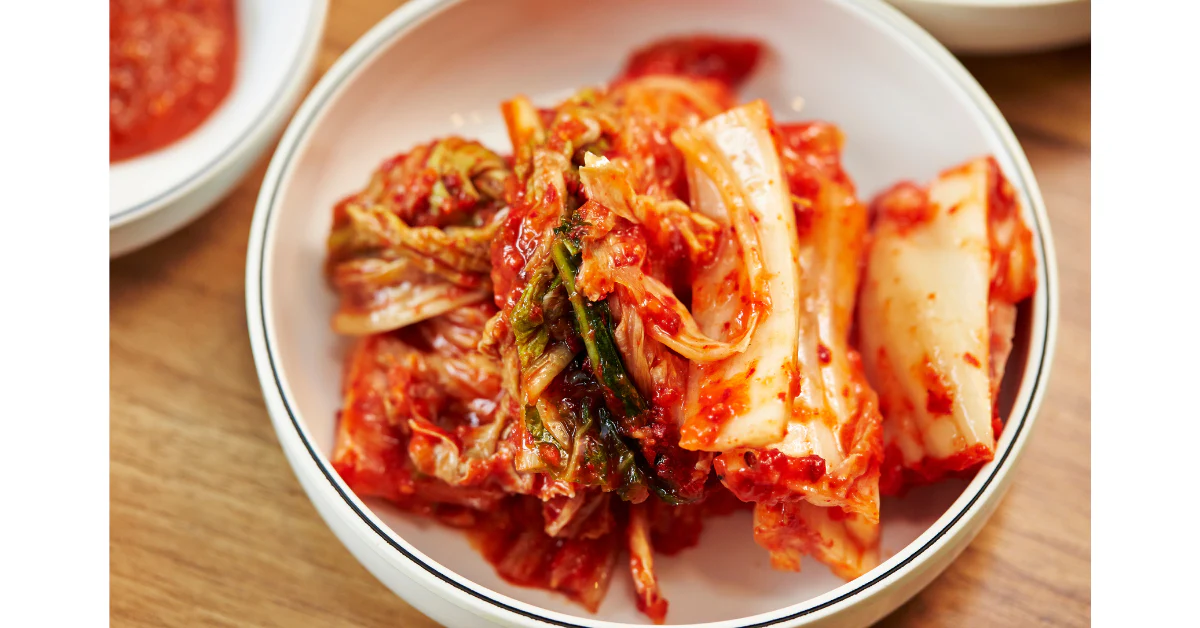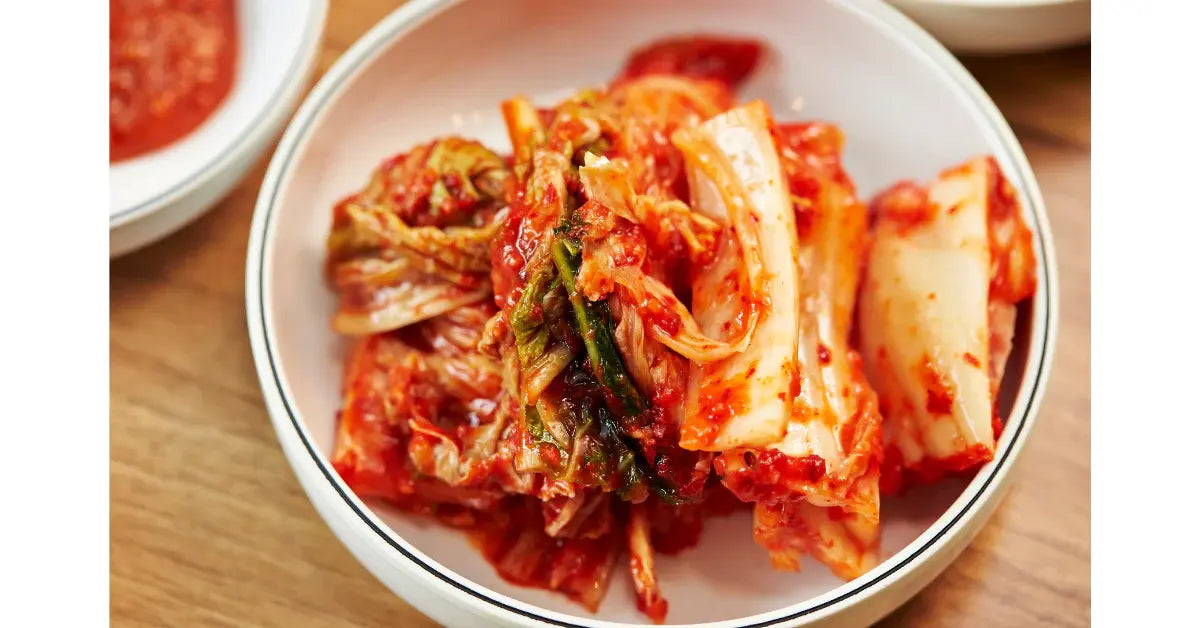
To those who don't know, what is kimchi, kimchi is a traditional delicacy eaten primarily by Koreans. In fact, about 95 percent of Koreans eat kimchi more than once daily, and more than 60 percent have it for breakfast, lunch, and dinner. This popular side dish dates back to 37 BC and can be eaten with every meal.

Kimchi is made with fermented napa cabbage and other seasonings, giving it a sour and salty taste. The fermentation takes one to two days, and you have to keep the cabbage at room temperature and then for two weeks in the refrigerator to develop the flavors thoroughly.
One reason why people love kimchi is that it is made without wheat and is thus gluten-free…or is it? In this article, we answer the question: is kimchi really gluten-free? In addition, we will provide answers on what is in kimchi and share other fermented gluten-free foods.
Does Kimchi Contain Gluten?
As already mentioned, kimchi is generally gluten-free; however, this largely depends on the ingredients used in preparing it. Thus, your store-bought or homemade kimchi can have gluten in it.
Below, we discuss some ingredients that make kimchi contain gluten:
● Flour

If you have had kimchi before, you know it is thick. Some people and kimchi manufacturers use glutinous rice flour to thicken it. Don’t be fooled by the name—this kind of flour is actually 100% gluten-free. However, some kimchi lovers and manufacturers may use different flour that contains gluten.
Therefore, whether making your kimchi at home or buying from the store, check the type of flour used to ensure it is gluten-free.
● Fish Sauce
A kimchi recipe might recommend using fish sauce to add flavor to the dish. However, some fish sauces contain gluten, so read the label carefully to ensure it is gluten-free. You can also replace fish sauce with hydrolyzed vegetable protein or oyster sauce. If you go for oyster choice, ensure it is made with corn starch, not wheat.
● Soy Sauce

Soy sauce is another substitute for fish sauce, and it will provide the umami flavor you crave. The downside, however, is that it is also not gluten-free because it is from crushed wheat and soy. Thankfully, there are alternatives to soy sauce that are gluten-free. One excellent example is tamari.
Tamari is a Japanese soy sauce made with little or no wheat. To ensure your kimchi is gluten-free, buy reduced-sodium tamari. But note that tamari is not soy-free, so avoid it if you are allergic to soy.
How Can You Get 100% Gluten-Free Kimchi?
Now that we’ve answered the question, “Is kimchi gluten-free?” we’ll share our recipe for 100% gluten-free kimchi.
If you’re allergic to gluten, the only way to ensure you do not eat kimchi that has gluten is to make it yourself. While some kimchi manufacturers will label their product gluten-free, it may still have traces of gluten. So it’s better to be safe than sorry by making your kimchi yourself.

Making kimchi at home is not rocket science; it’s pretty straightforward. You just need the essential ingredients, and having a fermentation kit makes things easier.
First, buy a big giant Napa cabbage. If it is your first time making kimchi, we recommend purchasing only one cabbage. Then get your fermentation jar ready; it should be big and have an air-tight suction top.
For the seasoning, you need:
- Salt
- Water
- Korean chili pepper powder
- Raw sugar
- Dried seaweed
- White radish
- Ginger
- Glutinous rice flour
- Spring onions
- Tamari
Depending on your taste, you could choose to add celery, cucumber, carrot, eggplant, scallions, spinach, beets, and bamboo shoots. All these ingredients are gluten-free.
Then follow these steps for your homemade gluten-free kimchi:
- First, cut the cabbage into pieces of the desired size, which largely depends on the size of the fermentation jar.
- Next, place the cabbage in a large bowl and add salt. Massage the salt into the cabbage with your hands, and continue until it softens.
- Then add water into the bowl, ensuring it covers the cabbage. You can use a plate to hold the cabbage down inside the water and leave it that way for one to two hours.
- Afterward, rinse and dry the cabbage and make your spice paste.
- Once you’ve mixed the spice and gotten the desired taste, mix it with the cabbage. Use your hands for the mix and keep at it until you’ve covered the entire vegetable.
- Next, place the mixture into a fermentation jar, and leave it at room temperature for one to two days. Then put it in a fridge for about two weeks to fully develop the flavor.
Once the flavor has fully developed, you have your kimchi, and you can store it in the fridge for up to a few months. Finally, ensure you use clean utensils anytime you’re taking out kimchi from the jar.
What Other Fermented Food Can You Enjoy Gluten-Free?

There are plenty of fermented foods that are gluten-free—read on to learn about some of them.
Sauerkraut is Usually Gluten Free
Like kimchi, sauerkraut is made from fermenting cabbage. It originated in China more than 2000 years ago when fermentation was the only way of keeping food from going bad. Kimchi is a well-known Asian side dish that offers a variety of health benefits, such as aiding digestion, among other kimchi benefits.
Yogurt is Gluten Free When It’s Homemade
Yogurt is made from fermented dairy and has zero gluten. However, note that some brands add gluten to their yogurt, so read the label to ensure what you’re buying is gluten-free. You can also make yogurt using a yogurt starter from Cultures for Health.
Sourdough Can Be Made With Gluten Free Flours
Sourdough is a great option if made with gluten-free flour. It is often used to bake bread for those who are gluten-intolerant or have celiac disease. You can buy the bread from a bakery or make it home using a gluten-free sourdough starter from Cultures for Health.
Final Thoughts: Is Kimchi Gluten-Free?

As already established, the best way to guarantee your kimchi is gluten-free is to make it at home. However, if you can’t and would rather buy ready-made kimchi in stores, check all the ingredients to confirm they are gluten-free.














